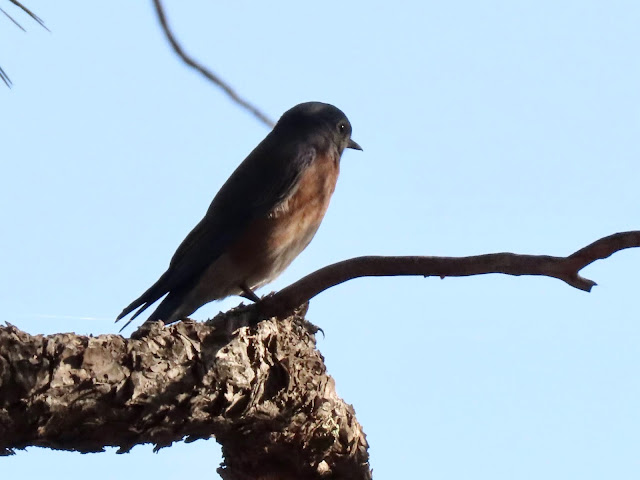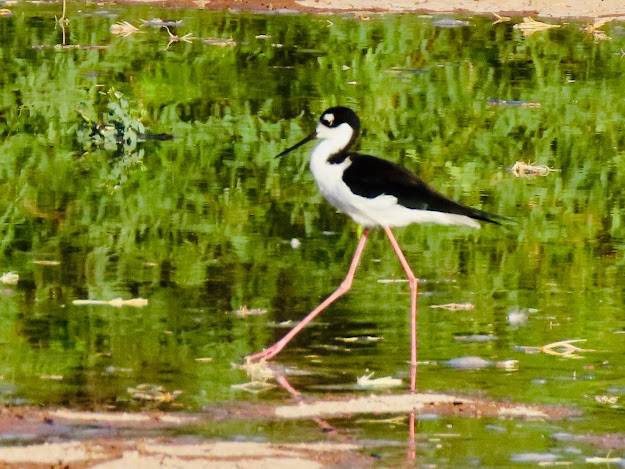Wednesday, September 23, 2020
With an early start from the Phoenix Valley, I was able to drive with little traffic on Route 60 up to Show Low to meet Hinde Silver at 7:45 a.m. for some birding. With our Covid arrangement for her to sit in the back seat, we drove to the rear casino parking lot in Pinetop where we met two of her birder friends, Loretta and Jan.
In our respective cars, we set out immediately for the South Fork of the Little Colorado River (LCR). I was leading the way eastward on Highway 260. About half way to our destination, a bird darted out in front of me and crossed to the other side: GREATER ROADRUNNER!! Braked appropriately to avoid misfortune but was amazed to find one of my favorite desert birds up here in the White Mountains of Arizona. Not superstitious at all, I chalked it up to the beginning of a good birding day!
On the drive into the birding area of South Fork past open meadows, we spotted two species of Meadowlark: two WESTERN and one EASTERN, with a very pale face and overall just paler than the Western. WESTERN BLUEBIRDs and several sparrow species were also foraging in the weedy grasslands full of seeds. Parking at a pull off at the riparian habitat, we immediately lifted our binoculars to the snag near the bridge over the Lower Colorado River (LCR).
Almost always a bird perches on that snag. Today, it was a TOWNSEND’S SOLITAIRE. It was not alone; its call was being answered from a distance. We would see them off and on throughout the busy morning.
From the far bank of the narrow LCR, a Red-shafted NORTHERN FLICKER took to the air.
Much of the habitat was juniper/pine with low shrubs and reeds along the river. Together we spotted both STELLER’S and WOODHOUSE’S SCRUB JAY (thanks, Loretta!).
Later, another special bird landed on the snag. Almost as plain-looking as the overall gray Townsend’s Solitaire of the Thrush family, this bird was larger, lighter in color (very pale gray) with black bill, black wings and short black tail. It’s long sharp beak reminded me it’s in the Crow family. For such a light-colored body, the black and white wings and tail catch the eye immediately. With white under-tail coverts as opposed to the continuous gray of the Solitaire, the positive ID of this bird was possible as it perched. In flight, it is more easily detected with white patches on its secondaries (close to its body) and, from beneath, it’s rather wide white-edged short tail. CLARK’S NUTCRACKER! They’re known for hiding pine seeds to feed their young. This is one of the few birds where the male incubates the eggs.
Poking through the thick bushes on a minimal trail toward the river, we hoped to come across one of the Gray Catbirds that favor this area. What we saw and heard were WILSON’S WARBLER (4) - at least. No Catbirds today.
Walking along the narrow paved road, we managed to spot one CANYON and one SPOTTED TOWHEE….CHIPPING SPARROW, DARK-EYED JUNCO, YELLOW WARBLER and one BLACK-THROATED GRAY WARBLER. But I persisted in walking farther forward toward an open piece of field full of blooming black-eyed susan. Often, I’ve succeeded in finding a CALLIOPE HUMMINGBIRD in this area and we were not disappointed. Our smallest hummingbird, with short bill, was observed from the rear giving us a bright green back, slight buffy on its sides. We never saw it from the front where the female’s white throat would contain little green dots of feathers, but its size alone was enough to ID this gem!
Another wonder at South Fork was not a bird but a creature I see very seldom: a Horned Toad!
View this checklist online at https://ebird.org/checklist/S73997360
From South Fork we continued through Eager on up to Wenima Wildlife Area to see what we might find. Almost noontime when we arrived, we got off to a good start with a perching juvenile RED-TAILED HAWK and would later see an adult flying overhead.
From the bridge, a female BELTED KINGFISHER perched on a limb over the Little Colorado River appeared to be taking care of lunchtime.
As we walked the single-file Beavertail Trail through a short willow thicket just a bit taller than our heads, birds zoomed out from one side to the other …giving us swivel neck but no identification! Only when they perched up did we luck out. AMERICAN GOLDFINCH! (Female). But was I able to get my camera on it? Nope; getting slower!!
View this checklist online at https://ebird.org/checklist/S73997178
Retuning toward Springerville, we stopped at Becker Lake at 1:00 p.m. for our own lunch and some birding. The lake was not as diverse with species as its most recent reports. But with PIED-BILLED and EARED GREBE, we were not completely wiped out with AMERICAN COOT.
I wasn’t very hungry so I walked up to the berm to look down on the marsh reeds at the northwest corner of the lake. WHOOP! WHOOP!
Looks like GREATER ROADRUNNER like this high desert area. I spooked two in the grass as I reached the top of the low berm.
Walking slowly, I managed a photo of the SPOTTED SANDPIPER that had greeted us at the concrete boat ramp but had walked up to this nice muddy area.
With another step or two, a big black bird lifted off. OMG. It was skinny and long-legged. Not a Green Heron; not a heron at all. WHITE-FACED IBIS! - by itself. That seemed unusual but so it was!
Farther along the berm, I managed a few poor shots of a male COMMON YELLOWTHROAT with its black mask.
Returning to the group still beneath of shade of the ramada, I suggested they come take a look. I felt sure they couldn’t believe me!
Though the roadrunner had seen enough of me, they were a no show but as we all stretched along the berm, who should come flying in but the very graceful WHITE-FACED IBIS — its black body and legs stretched for landing.
A nice 14 species at Becker Lake at mid-day was certainly okay with us.
View this checklist online at https://ebird.org/checklist/S74013293
Since Hinde is staying with a mutual friend, a dinner get-together had been planned. Missing for dinner were Jan and Loretta (who had a mishap when exiting Jan’s car at the casino parking lot). Jan ended up taking her to Urgent Care where she was treated and bandaged so unfortunately, they both missed the dinner. But two of Hinde’s other friends, Barb Davis and Aila (Eila?) were present. Barb visits our community from time to time and has shown some of the videos of birds she has taken and put together into a very professional showing. This night she shared one she had produced on desert birds at some of the desert locations where I love to bird! Very well done! And, enjoyable.
[Ordinarily that would be the end of Day #1, but when I drove into Fool Hollow Campground (Osprey #20) at a little after 6 p.m., someone had poached my rented site. The campground was marked as FULL and my site said RESERVED. Nonetheless, a woman with about 4 or 5 youngsters (from 8-14 perhaps) were there with a tent pitched and getting ready for bed. I pulled past the site, parked and got out with my receipt. (Gate personnel leave at 5 p.m.). The woman was as reasonable as I was so it all went down well; she was just scamming a night - or so she thought. Problem: it took them at least an hour to haul everything off the site. And, this was my first night experimenting with sleeping in my CRV with black-out curtains that I wanted to get up while it was light so I could see well. Not to be. With flashlight in hand, I sorted out each labeled cloth with velcro attached. Took a longer time than necessary but I stayed patient and by the time I could move ice chest, etc. to new locations, I stretched out on my very comfy bedding and crashed.]
DAY #2: Thursday, September 24, 2020
Hinde and I birded from 8:00 a.m. until 1:00 p.m. at the following locations:
(Directions can be found on White Mountain Audubon site.)
Show Low-Bluff Trail =. View this checklist online at https://ebird.org/checklist/S73997048
Scott Reservoir = View this checklist online at https://ebird.org/checklist/S73999533
Jacques Marsh = View this checklist online at https://ebird.org/checklist/S74003232
Pinetop-Woodland Lake Park = View this checklist online at https://ebird.org/checklist/S74007585
From my perspective, learning about new sites to bird in Show Low made this day special for me. At Show Low Bluff Trail, in addition to many sparrows (you know, I love them), we saw a BEWICK’S WREN and GREEN-TAILED TOWHEE.
At Scott’s Reservoir, a MOUNTAIN CHICKADEE was a nice find, along with a DOWNY WOODPECKER.
At Jacques Marsh, the reeds were changing color so that was special. Bird-wise, a flock of WHITE-FACED IBIS gathered on a spit of land, and I’ve never seen so many SORA at one location. Not only in the reeds, but walking on thick duckweed or just out there swimming. It seemed quite amazing!
Two photos of SORA below were taken by Hinde Silver:
At Woodland Lake Park, in addition to the requisite LEWIS’S WOODPECKER (reason for always stopping there), a Red-shafted NORTHERN FLICKER and a female WESTERN TANAGER kept our birding spark alive.
After such a good day with Hinde, I dropped her at Suzanne's (who came out to the car) so I said a temporary good-bye to both of them until they return to the Valley next month.
When I returned to Fool Hollow Lake Campground, I sat by the lake for awhile, then worked on bird list details and had “dinner” (last night’s good left-overs) at the picnic table. Birds came to me for a change!
After a good night's sleep, I rose early to stretch my legs by walking. Sparrows were thick in the grasses (full of seeds) and a flock of CANADA GOOSE lifted off from a distant part of the lake for a fly-by below my campsite.
The few days in cooler temps (got only to 85°F) and fresher air left me feeling invigorated. Returned home after this 473-mile round trip birding adventure before 11:00 a.m. at 99°F and rising!
View this checklist online at https://ebird.org/checklist/S74012808
View this checklist online at https://ebird.org/checklist/S74016536
View this checklist online at https://ebird.org/checklist/S74032113
* * *























































